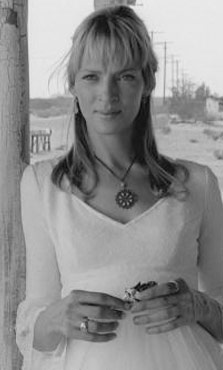 “Volume Two” is a so-so conclusion to a flawed but promising first half. Rumors of this film’s “heart” are baffling considering that the Bride’s proof of three dimensionality comes not from her character but in the form of a person, her daughter, who is little more than a device in an unstrung last act built on a facile inversion. The showdown with David Carradine’s ultra-suave Bill is satisfying, after so much carnage, but then again when the noisy chaos drops to a whisper it borders on boring. “Volume Two” is a so-so conclusion to a flawed but promising first half. Rumors of this film’s “heart” are baffling considering that the Bride’s proof of three dimensionality comes not from her character but in the form of a person, her daughter, who is little more than a device in an unstrung last act built on a facile inversion. The showdown with David Carradine’s ultra-suave Bill is satisfying, after so much carnage, but then again when the noisy chaos drops to a whisper it borders on boring.
The film’s charms are scattered about like gems in a junk yard. Pai-Mei’s training session is sublime. The wall-wrecking sword fight in the trailer between The Bride and Elle Driver might be one of the nastiest ever put on film. Taken on its own, our first full encounter with Bill is cool in its way, with the silver-tongued villain managing to entrance us with a wonderful interpretation of Clark Kent and Superman, among other things. And, as with Volume One, the soundtrack is superb.
If only Tarantino’s pet enthusiasms didn't keep bloating the movie. Replete with broad, arid, and often tedious spaces in both landscape and dialogue that are supposed to supply Spaghetti Western “atmosphere”, “Kill Bill: Volume Two” proves once and for all that Tarantino is way too precious about his own highly modulated coolness. The flim drags in places. The taut atmosphere he goes for often slides into blankness. Aside from stylistic excess, though, some of the film’s problems have to do with careless storytelling spoiling tone and mood.
One example will suffice. The Bride’s escape from premature burial is preposterous not because it violates the laws of our universe but because Tarantino didn’t bother to invent consistent laws for his. As the buried Bride first figures out where she is, we feel claustrophic and terrified as he marks out the narrow space she’s in. Then, as she karate chops the inside of her coffin, Tarantino vividly depicts the raw physics of knuckles trying to smash wood. This is masterful filmmaking. Her desperation becomes visceral for the audience with every crack of her fist on the unyielding coffin lid.
The next moment, though, the Bride is piercing six feet of soil as if leaping up through a cloud of mist: problem solved. Sure, it’s fun to see the Bride exhibit her Shaolin superpowers—I understand that brash inconsistency is a staple of midnight movies—but the issue is one of pumping up and then puncturing an audience’s expectations. We keenly anticipate the pleasure of watching the Bride escape from her predicament, especially once we know she’s in a world where soil’s heavy and punching solid wood hurts like hell. “How will she do it?” we ask, breathlessly. Answer: Tarantino’s film-geek piquancy.
Such inconsistency is troubling. These movies get the job done with pure buck-shot blasts. Over the course of the two movies, “Kill Bill” gradually suggests that, for all his gifts, Tarantino isn’t disciplined enough to play to his strengths. If he’d settled on one style, or one mode of storytelling, or a more tightly-focused narrative, there are easily six or seven loose strands he might have woven into a masterpiece. Sure, “Kill Bill” is plenty good as is, faults and all, but how good might it have been?
After all, many of the set pieces are well-executed, the mythology of the assassins is nifty, and a slew of fine actors performed with full faith in their director’s vision. Michael Madsen and Daryl Hannah are marvelous. Thurman is a solid anchor. The material they’re working with is just too baggy and uneven. The two movies needed rigorous editing. A single whiplash revenge film would have worked better. Pared down into comestibility, the airy, dragging scenes in these movies would no doubt shape up into a delicious two-hour cheeseburger. But from the evidence it seems “no” is apparently a word Tarantino doesn’t hear much of anymore. |